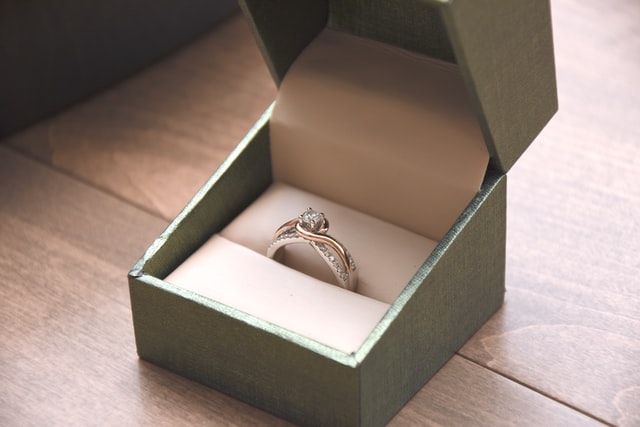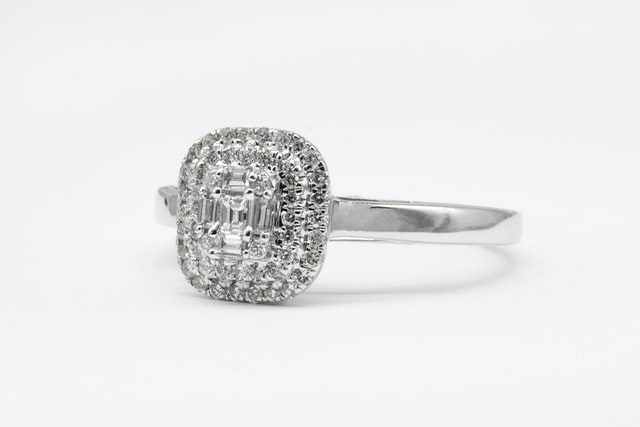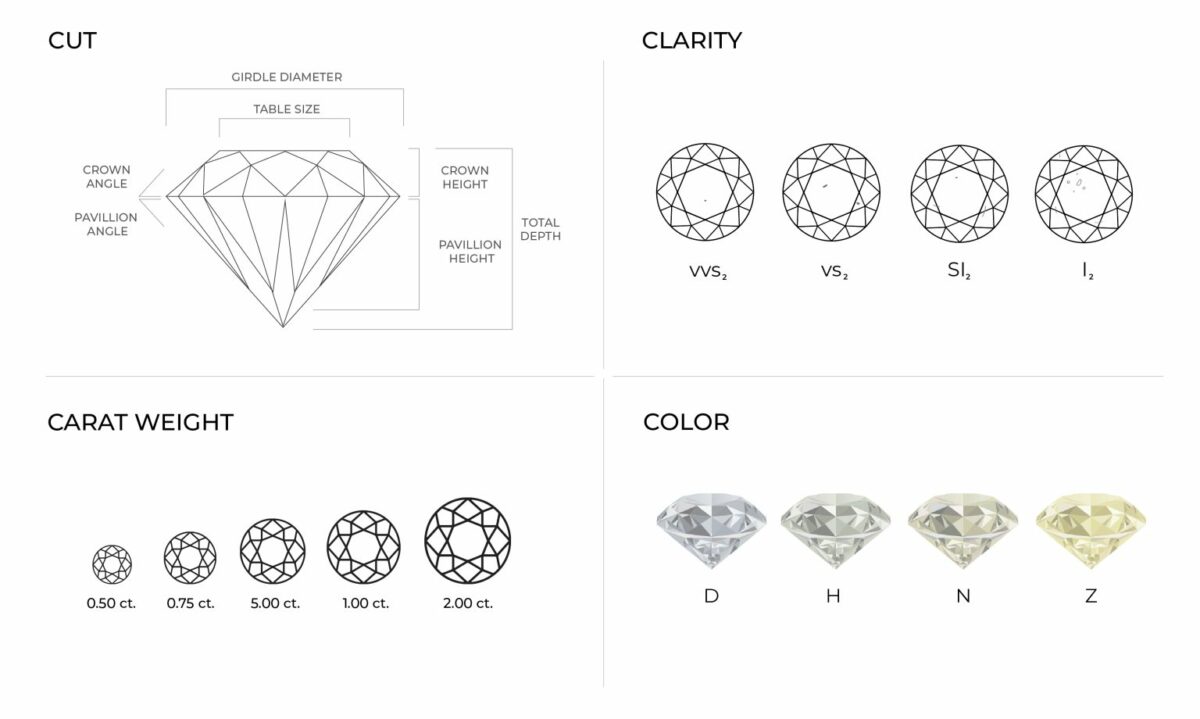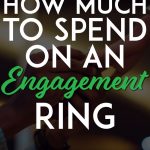How Much to Spend on an Engagement Ring?
Some products in this article are from our partners. Read our Advertiser Discloser.
Now that you’ve found “the one,” you’re thinking of popping the big question. But how much should you spend on an engagement ring?
Don’t be fooled into thinking that the size of the diamond determines the amount of your love. Knowing her style and understanding her expectations can help narrow down your price range before you walk into a jewelry store.
Here is our take on some key components before you start shopping.
How Much Should an Engagement Ring Cost?

Have you seen the price of diamonds lately? They’re not cheap. A study by The Knot found that the average price of an engagement ring was $6,351.
When it comes to pricing, there are a lot of factors that go into how much a diamond costs. The “four Cs” determine the bulk of the price.
Depending on cut, carat, color and clarity, a classic one-carat diamond can range from $2,000 to more than $12,000.
You don’t have to end up with a cheap-looking ring just because you’re on a tight budget. High-end retailers such as Cartier and Tiffany & Co. have much higher markups than most.
You can save a considerable amount of money by shopping around. Before you even do that, though it’s important to talk about expectations with your fianceé.
Understanding Expectations
Most women start dreaming about their wedding at a young age and already have an idea of how they want their engagement ring to look. The best way to know what kind of ring your partner is looking for is to ask.
An engagement ring is only part of the cost of getting married. There’s also the wedding venue, caterer, photographer, cake and wedding dress to think about.
Talking about what you both want in these categories will get you on the same page about how much you’re comfortable spending.
When it comes to the ring, you’ll also want to consider the shape of the diamond, the type of setting, and whether you already have a family heirloom you could use.
Your fianceé’s preference for the kind of metal — whether it’s white gold, platinum, yellow gold, or rose gold — will factor into the total cost, too.
If you want the ring to be a surprise, you can still get an idea about what her expectations are. Looking at other jewelry she owns can help you figure out what kind of metal she likes and what her style is.
Talking to family members or friends can guide you to the right choice, too.
Know How Much You Can Spend
You want to knock your bride-to-be’s socks off with the perfect engagement ring, but first you need to know what you can afford to spend. After all, your relationship is more than the engagement.
There are significant costs associated with planning a wedding, reception and honeymoon, and you have your future to think about, too.
Since you’ll likely merge your finances when you get married, you shouldn’t spend more than you can reasonably afford. If you’re like most young professionals who carry an average of $37,000 in student loans, you don’t want to go into more debt to purchase a ring.
Starting your lives together burdened with debt will put added stress on your marriage right from the beginning.
Buying an engagement ring without incurring any debt is the ideal solution, and accounting for the factors above should give you a pretty good idea of what you can spend.
But if you’re planning to finance part of the purchase, don’t borrow more than you can reasonably pay off in a couple of months.
Rules for How Much to Spend on an Engagement Ring
Everyone has an opinion on how much money you should use to buy an engagement ring. From the two-month rule to matching the national average, to buying a ring based on the age of the woman, there are a lot of crazy ideas.
The Two-Months’ Salary Rule
You may already be familiar with the idea that you should spend two months’ salary on an engagement ring. It’s the guideline that tries to dictate what you can afford to spend, except that it doesn’t account for your entire financial picture.
Plus, the notion of spending two months’ wages on a ring started as a marketing campaign in the 1980s.
Created by De Beers, the most prominent name when it comes to diamonds, the two-month rule was designed to lure buyers into connecting the amount of money they’re willing to spend with the worth of their relationship.
The two-months’ salary rule is a myth. Deciding the budget for your significant other’s ring is a very personal decision, and a commercial shouldn’t dictate what you spend.
If you’re like most people who are engaged, you’re near the start of your career and carrying student loan debt. Spending two-months’ salary on a ring might not be possible.
The National Average Rule
You want to get your girl a ring she is proud of, and there is pressure to buy one she can show off to her family and friends.
Spending what the average man spends on an engagement ring might seem like a reasonable decision, but it could be a lot more than what you can afford.
According to a 2017 study by Ebates, almost half of men and women in the U.S. expect to spend $1,000 to $5,000 on an engagement ring. This is slightly less than the national average price of $6,351.
Don’t feel pressure to measure up to the average man when it comes to buying the perfect ring. You can use this rule as a starting point, but there’s no need to break your budget to get a great engagement ring.
The Age Rule
Perhaps the most irrational rule when it comes to buying an engagement ring is the age rule. This says that you should choose the size of the diamond based on the age of the woman.
That means if you’re young and in love and plan to propose to your 18-year-old partner, you should buy a 1.8-carat diamond ring. With the average woman being 27 years old when she gets married, you’d need a 2.7-carat diamond.
The trouble is, if you’re getting married later in life, planning a second (or third) marriage, or simply prefer older women, you’ll need a much larger diamond.
According to this rule, you should buy a 5.0-carat diamond if you’re marrying a woman who is 50. That seems ridiculous.
While you can use the two-month rule or national average as a general starting point, you should throw this “age rule” right out the window.
Make Your Own Rules
The absolute best way to find the right engagement ring is to make your own rules. This usually starts with you and your significant other having an honest conversation.
If you’re planning to share a life, talking about expectations and finances is something you should do anyway.
Since buying a ring is just the beginning, starting with a budget is crucial. Talking with your partner about what kind of wedding you’d each like to have plays a part when engagement ring shopping, too.
If having a big wedding isn’t a priority, you might justify spending more on a ring because you’ll save money on the reception. Or maybe you’ll postpone your honeymoon until later so you can splurge on a more expensive ring now.
It might be tough to balance the reality of your finances with the dreams you’ve had about this time in your life. As with most things, it comes down to communication.
Talking about the cost of a ring isn’t romantic, but it’s essential. It’ll give you an idea of what is important when it comes to buying an engagement ring and planning a wedding.
That can save you both from feeling disappointed if you take a blind guess and miss.
And remember that a more expensive ring won’t make your marriage better. Spending more than you can afford on a ring won’t make either of you happy if you’re struggling to make ends meet after you say “I do.”
Finding the Right Engagement Ring

It’s much easier to pick out a ring than it is to find the person you want to spend the rest of your life with. But there are as many different options as there are women in the world.
You might wonder how you’ll ever find the right engagement ring.
If you want to design it yourself and save money, then we have the perfect designer. Check out James Allen which has 100% money back guarantee.
However, many women already have a clear vision of how they want their rings to look. If you’re going to get the ring precisely right, you can always take her shopping and let her pick it out.
Traditionally, the man selects the ring and presents it when popping the question. And if this is more your style, there are a few points to ponder to find the right one.
- Her lifestyle
- Personal style
- Her ring size
- The four Cs
- The metal
- Protection
Her Lifestyle
Most women wear their engagement ring every day, and removing it for work, sports, or hobbies is inconvenient. When picking out a ring, you’ll need to consider her lifestyle.
Ask yourself what she does each day. If she works a lot with her hands, as a chef, landscaper, or welder does, you may want to look at rings without high-set diamonds.
If she’s a nurse, physical therapist, or in another profession where she cares for people, having an elevated diamond can cause it to get caught on clothing or scratch another person.
Does she have a hobby that causes her hands to get messy? A more traditional setting, like a solitaire, is easier to clean. This is perfect if she likes to get her hands dirty in the garden or art studio.
Or for someone who is active in sports or weightlifting, going with a simple wedding band that she won’t have to remove when she works out might be a better option.
Personal Style
Every woman has her own style. Some are more reserved, others like to stand out in a crowd. To understand her personal style, pay attention to the fabrics she chooses, and the colors and styles she wears.
You can also take pictures of jewelry she already has and bring them with you to the store. The jeweler can help you choose the right design and shape of the diamond based on the selections she already has.
It’s hard to go wrong when buying a diamond if you go with a classic solitaire. That said, everyone has their own style, and making a more personalized choice can add meaning and sentiment to the ring.
Her Ring Size
You may think her ring size doesn’t matter because you can always take the ring back to the store and have it sized to fit. Keep in mind certain types of ring designs are challenging to resize.
You’ll want to ask the jeweler about this before committing to a purchase.
It’s also disappointing to send the engagement ring back to the jeweler and wait for it to be resized after the excitement of the proposal.
The Four Cs

Every diamond gets a grade according to the 4 Cs: carat, cut, color and clarity. It’s these four Cs that determine the worth of the stone. The clearer, more flawless and colorless the diamond, the more it costs.
You can learn more about diamond education on the James Allen Education Center page. However, we’ll briefly touch on the subject here.
Carat
“Carat” refers to the weight of the diamond. A metric “carat” is defined as 200 milligrams of weight. The weight of the diamond is the starting point when determining its value.
Ironically, you might find that a full 1 carat diamond can be quite a bit more expensive than a 0.99 carat diamond. This is because there are what is often termed “magic” sizes in diamonds.
“Magic” sizes are 1/2 carat, 3/4 carat and 1 carat. Once you reach those exact weights, value can rise significantly. A diamond size just a touch smaller than these “magic” sizes isn’t noticeable to the human eye.
However, value-wise it can make a difference.
Cut
The cut of a diamond also matters when determining value. Cut refers to the shape of a diamond. There are several types of cuts of diamonds:
- Round
- Heart
- Square
- Pear
- Oval
And others. The cut of a diamond directly affects its ability to transmit light. This is why cut is so important to the value of a diamond. The cut affects a diamond’s ability to sparkle.
The cut of a diamond is divided into categories such as:
- Poor
- Fair
- Good
- Very good
- Excellent
As with size, the cut of a diamond can significantly affect its value. You can put two 1-carat diamonds side-by-side. However, the one with the better cut will cost more and look more “sparkly”.
Color
Interestingly, the color of a diamond actually refers to its lack of color. Diamonds can range from shades of white (or clear) to yellow. The more “colorless” a diamond is, the more value it has.
Diamond “colors” are rated by letter. As an example:
- D, E and F color-rated diamonds are considered colorless
- G, H, I, and J color-rated diamonds are considered near-colorless
- K, L and M color-rated diamonds are considered faint
- N, O, P, Q and R color-rated diamonds are called ” very light” meaning they have a very light yellow tint
- S Through Z color-rated diamonds are called “light” meaning they have more of a yellow tint
More color (when comparing equal sizes, clarity and cuts) means less value and lower price. Interestingly, diamonds can be rated with more yellow than a Z code, or a different color such as brown.
These types of diamonds are considered “fancy” diamonds and typically cost more money.
Clarity
The fourth “C” in diamond assessment is known as “clarity”. “Clarity” refers to the absence of blemishes or inclusions in a diamond. A “blemish” is an external characteristic that makes a diamond less valuable.
An inclusion is an internal characteristic that makes a diamond less valuable.
The GIA is the largest and most respected non-profit source of gemological knowledge.
The GIA clarity scale reads as such:
- FL rating refers to a flawless diamond with no blemishes or inclusions
- IF rating refers to an internally flawless diamond
- VVS1 and VVS2 refer to diamonds that have very, very slight inclusions
- VS1 and VS2 ratings refer to diamonds that have very slight inclusions
- SI1 and SI2 diamonds have slight inclusions
- I1, I2 and I3 diamonds have inclusions that may affect transparency and brilliance
Obviously, the more flawless a diamond is, the more valuable it is. How can you decide on how much to spend on a ring while taking into account the 4 Cs?
We recommend starting with what’s most important to you–and your bride. Would you rather have a larger diamond with more imperfections?
Or, would you rather have a smaller diamond with less imperfections? Decide the answer to that question. Then start taking into account the 4 Cs.
Look at varying diamonds within your budget range, and learn what you and your bride prefer. Decide whether quality or size is most important.
Most importantly, be familiar with these terms and understand how they impact the cost and the beauty of the stone. Do this before you get to the jewelry store. And only get a diamond that is GIA certified or AGS certified to make sure you’re getting a quality stone.
The Metal
The type of metal that holds the diamond also plays a role in the overall cost of the ring. The most popular ring metal is white gold.
To keep the silvery white color, the ring is coated with rhodium that resists scratches and tarnishing. But the rhodium does wear off and will require re-plating over time.
Platinum is a naturally white metal, though it’s more expensive than white gold. It stands up better when it comes to wear and tear, so it’s a good option for women who lead active lifestyles.
It’s also an excellent choice for people with sensitive skin, since it’s naturally hypoallergenic.
Yellow gold is the traditional choice for engagement rings, and it features a high contrast to the brilliance and shine of the diamond.
For a unique look, rose gold is another option. It isn’t as popular as the other three choices but is more durable than yellow or white gold.
Ultimately, the type of metal you choose for the engagement ring will probably depend on the preference of your bride.
Protection
Most jewelry stores will offer a plan that you can buy for additional warranty and insurance protection.
And rightly so, since purchasing an engagement ring is a significant investment.
Rings are small and can easily fall down a bathroom drain or slip off her finger at the beach. There’s also a chance of theft or damage, so you’ll want to add the cost of a protection plan into your budget when shopping for a ring.
Shopping for an Engagement Ring
When it comes time to pick out a ring, a few tips can ensure you get the best value. To help with your budget, here are some ideas on how to save money on an engagement ring.
- Don’t shop at peak times. The busiest time to buy a diamond is from Thanksgiving to Valentine’s Day. You’ll pay more during these peak times.
- Know before you go. It’s easy to get carried away
in the moment when you’re shopping and spend more than you can afford. Know what you’re looking for in terms of size, type of metal, and shape of the stone before you go. You can also consider giving up a fraction of carat size to savemoney, since a 0.78 carat stone costs a lot less than a full carat.
- Pick the right setting. You can make a small diamond look bigger if you find a ring with a flashy setting. Also, a halo design can add sparkle without adding a lot of cost.
- Go with an alternative shape. Round-cut diamonds are by far the most popular, which means they’re also the most expensive option. An oval or pear-shaped diamond will often cost less.
- Shop around. Some reputable online jewelers offer significant savings on engagement rings. Do your research ahead of time to get the best diamond for your budget. Check the prices and quality of rings at online retailers like James Allen or
Blue Nile. Also sign up to receive special offers and discounts from local jewelers including Kay Jewelers, Zales, Fred Meyer Jewelers, Jaredand others.
- Check out estate sales. Engagement rings that are brand new always cost more than one you buy second-hand. Estate sales are a great place to pick up a quality ring at a fraction of the cost. To avoid misunderstandings, make sure your new bride doesn’t mind getting a used ring.
- Consider other stones. No law says an engagement ring has to have a diamond. You can go with a white sapphire for a diamond-like look. Opting for a blue sapphire, rubies, or an emerald stone are also popular choices.
Going into debt to buy an engagement ring isn’t the wisest thing to do, but not everyone has thousands of dollars set aside to pay cash for a ring upfront.
Saving a little now to help with the cost means you won’t have to borrow as much later when you’re ready to propose.
If you’re not in a position to pay cash for a ring, financing is an option but a good one. If you don’t pay off the balance in full before the promotional period ends, interest rates can skyrocket after that.
Another option is to finance the ring directly through the jewelry store, though they tend to have higher interest rates. It might seem easier because you’re already there at the jewelry store, but let yourself get pressured into doing it.
If you do use the store’s financing option, read the fine print carefully to make sure you understand the terms before signing.
Summary
Even though they say “When you know, you know,” choosing to propose to your partner is a big decision. When you’re ready, take the time to discuss finances and expectations before buying an engagement ring.
Getting married and joining your life with another person is stressful enough. Don’t add to the stress by letting yourself feel pressured to spend more than you can reasonably afford.
If you want to start with the “two months’ salary” rule or spend close to the national average, you can. But make sure you adjust how much you’re going to pay according to your financial situation.
Whatever your budget, you can find the perfect engagement ring to represent the love you have for each other.


I am very surprised Well Kept Wallet would promote the diamond hype. Diamonds are pretty, but worth much less than their emotionally inflated prices command. If you are going to spend two months salary on your true love, give an investment account, stocks, or something else that has real value.
I understand what you are saying. An investment account would be more practical and give back in the long run. However, some people will only give the real thing, and this post was intended to help them not go overboard when doing it. Thanks for your comments!
Or you could do what my wife did and chose not to have any engagement ring. Just a plain gold band that cost $71 for each of us. I guess it worked so far for the first 40 years we’ve been married!